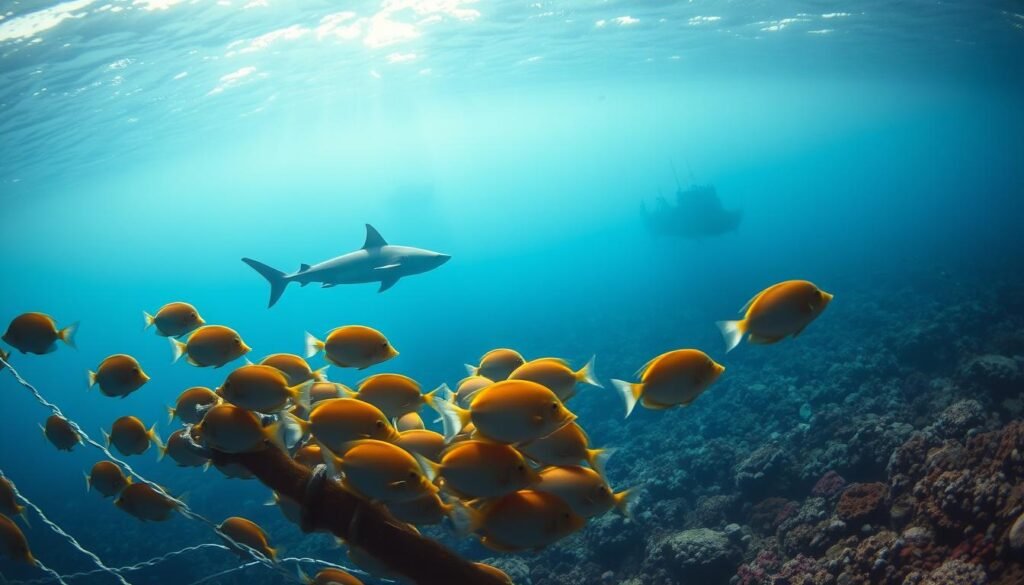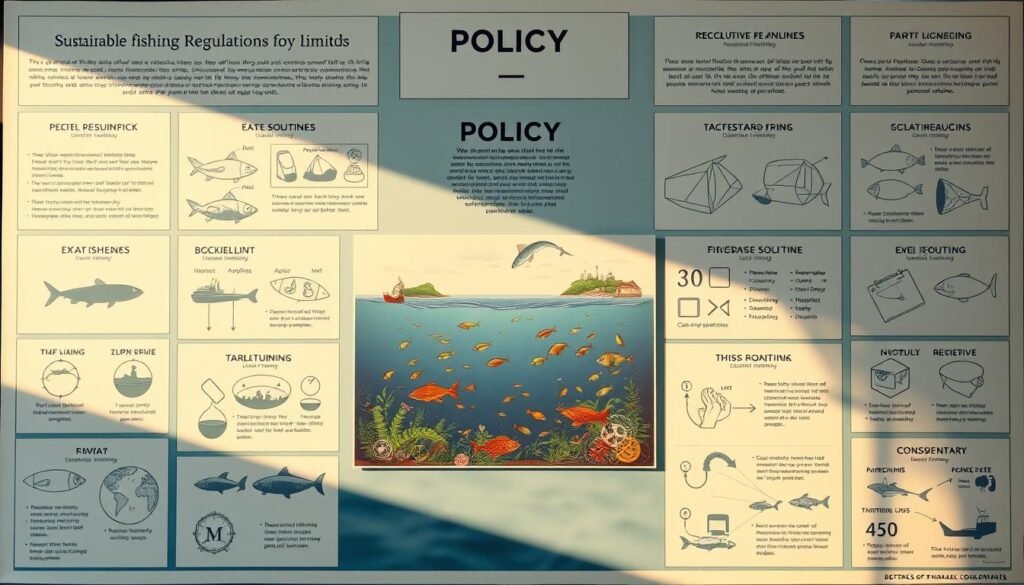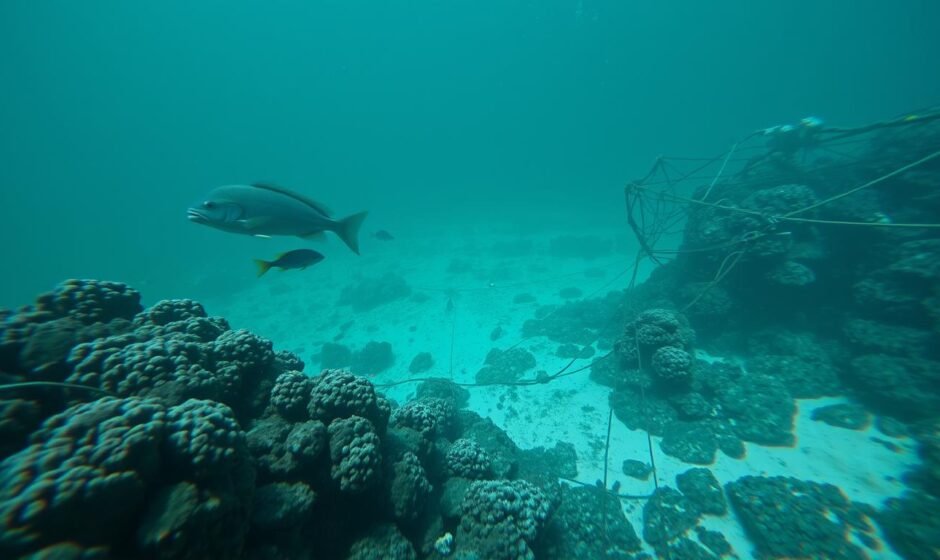Did you know over 85% of global fish stocks are overfished or fully exploited? This shocking fact shows how much our oceans are struggling. Overfishing has made fish populations drop dramatically. With more people eating fish, the problem is getting worse, harming ocean life and biodiversity.
Overfishing affects more than just the environment. It also hurts local fishing communities and the seafood industry. We need to find ways to fish sustainably. This article will look at the effects of overfishing and how we can protect our oceans for the future.
Key Takeaways
- Over 85% of global fish stocks are either overfished or fully exploited.
- Marine fish consumption has surged by more than 60% from 1990 to 2018.
- The decline in fish populations disrupts marine biodiversity and food chains.
- Sustainable alternatives are essential to mitigate the impact of overfishing on marine ecosystems.
- Local fishing communities and economies are heavily affected by overfishing practices.
Understanding Overfishing and Its Definition
Overfishing happens when fish are caught too fast for them to reproduce. This can cause big problems for the ocean’s health and its many species. Things like bad management, more people wanting fish, and better fishing gear make it worse. Knowing about overfishing and how it affects fish numbers is key to solving the problem.
What Constitutes Overfishing?
Overfishing means catching too many fish, so they can’t come back. In 2017, about 34% of fish in the sea were overfished. The next year, it was almost the same, at 33.1%.
Back in 1974, 90% of fish stocks were healthy. But by 2015, that number dropped to 66.9%. These problems not only reduce fish numbers but also harm the ocean and local fishing communities.
Global Statistics on Fish Populations
Fish population numbers show we need to fish better. Only 7% of fish are caught too little, while 59.9% are caught just right. The Mediterranean and Black Sea have the worst fish numbers, at 62.2%.
Sharks and rays have lost 71% of their numbers in 50 years. Over 85% of fish are affected by overfishing. We must manage fishing better to keep the ocean healthy and feed people.
| Year | % of Overfished Stocks | Biologically Sustainable Stocks |
|---|---|---|
| 1974 | 10% | 90% |
| 2015 | 33.1% | 66.9% |
| 2017 | 34% | – |
| 2018 | 33.1% | – |
We must act fast to stop overfishing. Changing to better fishing ways is essential. Understanding these issues is the first step to a healthier ocean.
The Ecological Impact of Overfishing
Overfishing is a big problem for marine ecosystems. It leads to many ecological issues. The removal of key species disrupts the balance in marine food chains. This affects other organisms that depend on these species for survival.
Understanding these relationships shows we need to act fast. We must preserve marine biodiversity and manage our fishing practices wisely.
Disruption of Marine Food Chains
When key species are overfished, marine food chains are severely disrupted. Apex predators like sharks and tuna are vital for controlling the numbers of smaller fish. Without them, prey species can grow too fast, causing algal blooms.
These blooms can make the water oxygen levels drop. This threatens the health of entire ecosystems. It shows how serious the ecological consequences of overfishing are.
Loss of Biodiversity in Marine Ecosystems
Overfishing is causing a huge loss in marine biodiversity. About 30% of global fish stocks are overfished. This is making marine habitats less diverse.
Coastal communities and vulnerable populations that rely on fish for food are facing big challenges. It’s vital to protect marine biodiversity. This is key for keeping ecosystems healthy and supporting both wildlife and human livelihoods.
Using sustainable fishing methods is essential. This is outlined in this informative article.
Habitat Degradation
Destructive fishing practices are causing habitat degradation. Techniques like blast fishing harm coral reefs. These reefs are vital for many marine species.
The damage to these habitats affects fish populations and the ocean’s health. It’s important to preserve habitats. This is key to reversing the negative effects of overfishing and keeping marine biodiversity intact.
Socioeconomic Consequences of Overfishing
Overfishing does more than just deplete fish stocks. It also harms local fishing communities. These communities depend on fish for food and income. Healthy marine ecosystems are vital for both the environment and these communities.
Effects on Local Fishing Communities
Coastal populations often rely on fish for their diet and income. In places like Africa and South Asia, fish is a big part of their meals. When fisheries collapse, like the Atlantic Canadian cod fishery in the 1990s, it’s hard for fishers to find new jobs.
Switching careers can be tough. Local cultures and economies rely on fishing. Losing access to the sea can be devastating.
Economic Implications for the Seafood Industry
The seafood market is hit hard by overfishing. Over a third of global fishery stocks are overfished. This leads to higher prices and less fish available.
In 2018, the global trade in fish and seafood was worth about USD 150 billion. This shows how big the industry is. But overfishing stops us from using sustainable practices that could help the market.
Identifying Key Species Affected by Overfishing
Overfishing is a big problem for our oceans, harming many key species. The decline of famous fish is a major worry. It’s also linked to bycatch, which hurts non-target species. We need to understand these issues to save our oceans.
The Decline of Iconic Fish Species
Species like bluefin tuna and beluga sturgeon show how bad overfishing is. Bluefin tuna’s numbers have dropped to just 21 to 29 percent of what they were in 1970. Longlines, up to 100 kilometres long, catch thousands of fish at once. This has led to a big drop in their numbers.
Impact on Bycatch Species
Bycatch adds to the problem of overfishing. Sea turtles and seabirds get caught in fishing gear meant for other fish. This is a big worry for both ethics and the environment. Using selective fishing can cut bycatch by up to 50%, which is a big help.
It’s important to know about protecting these fish and bycatch species. Marine protected areas can really help. They can make fish numbers go up, helping both the fish we want and those we don’t.

The Role of Aquaculture as a Solution
Aquaculture is seen as a key solution to overfishing problems. It offers ways to meet seafood demand while protecting the environment. By using sustainable aquaculture, we can reduce the strain on wild fish and ensure a steady supply of quality seafood.
This method not only fulfils consumer needs but also supports environmental health and community well-being.
Benefits of Sustainable Aquaculture Practices
The benefits of aquaculture are clear. It has seen rapid growth, outpacing fisheries and livestock. Today, aquaculture produces over 60 million tonnes of seafood, helping feed billions.
Seafood from both fisheries and aquaculture is vital for 2.9 billion people. Sustainable practices improve nutrition and access, helping vulnerable groups like pregnant women and children.
Shellfish farming is good for the environment, improving water quality and marine life. Integrated multi-trophic aquaculture (IMTA) takes this further by reducing waste. People are willing to pay more for sustainable seafood, showing their support for eco-friendly choices.
Reviving traditional aquaculture methods, like Hawaiian fishponds, can also boost local economies and create jobs.
Challenges in Aquaculture Development
Despite its promise, aquaculture faces challenges. Environmental damage, disease, and habitat loss are major concerns. Intensive farming can pollute as much as a town of 240 people.
To overcome these hurdles, we need strong regulations and certification programs like the Aquaculture Stewardship Council (ASC). These standards help reduce harm to habitats and water pollution. By tackling these issues, aquaculture can help stabilise seafood supplies and ease overfishing pressures.
Policy Approaches to Combat Overfishing
Overfishing is a big problem that needs both international and national efforts. International fishing rules are key to setting standards for countries. The European Union’s Marine Strategy Framework Directive is a good example. It aims to protect at least 30% of marine areas by 2030.
These efforts help fish populations recover. They also promote sustainable fishing. The Marine Stewardship Council (MSC) is another important group. It checks if fishing is done right and helps consumers make better choices.

Without strong rules and checks, managing fisheries is hard. This makes it hard to keep fish populations healthy.
National policies are also vital in fighting overfishing. Countries need to enforce laws against illegal fishing. They should also help local communities switch to sustainable fishing.
Training these communities in sustainable fishing is key. It helps them use methods that are good for the environment.
- In 2023, about 47% of fish stocks in the EU were overfished, showing the urgent need for action.
- 9.1 million tons of fish were thrown back into the sea in 2019, showing poor management.
- Most EU countries don’t enforce fishing laws well, making it hard to stop illegal fishing.
Strong policies at both levels are essential. They help keep fish stocks and marine ecosystems healthy. Governments and international groups must work together to ensure sustainable fishing for the future.
Community Efforts and Grassroots Movements
Community-driven sustainable fishing is becoming a key way to fight overfishing and protect our oceans. These efforts come from grassroots movements that aim to educate and involve local communities. You can help by supporting these movements and encouraging others to join in.
Local Initiatives for Sustainable Fishing
Many local projects are making a big difference in sustainable fishing and conservation. For example, the Alaska Sustainable Fisheries Trust has given out almost 490,000 free seafood meals. This has helped vulnerable communities a lot.
In Bangladesh, the Bay of Bengal Programme is working to make fishing sustainable across four countries. It helps manage fisheries responsibly. Also, the Community Mangrove Forest Conservation of Baan Bang La has protected the community from tsunamis and helped the marine environment.
Engaging the Public in Conservation Efforts
Getting local people involved is key to conservation success. The Kuruwitu Conservation & Welfare Association has seen a big increase in biodiversity in a protected area. This is thanks to their effective community engagement.
Programmes like those from Oceana aim to educate and engage the public in conservation. Working together with NGOs and local groups helps build strong support for sustainable fishing policies.
Innovations in Sustainable Fishing Technologies
New technologies in fishing are key to solving overfishing problems and keeping our oceans healthy. These innovations help us catch fish in a way that’s good for the environment. They make sure we use marine resources wisely.
Use of Selective Fishing Gear
Selective fishing gear has changed the fishing world. It catches only the fish we want, not others. This helps protect sea turtles and other marine life.
In the Mediterranean, new trawl nets have improved fishing. They catch fewer unwanted fish. But, making these nets bigger can hurt the fishermen’s profits. Finding the right balance is important.
Advancements in Marine Monitoring Techniques
New ways to watch over the sea are helping fishermen. Tools like GPS and sonar help find fish faster. This saves fuel and time, making fishing better for the planet.
Marine Protected Areas (MPAs) are also making a difference. They keep fish populations up by protecting their homes. MPAs show that with care, the sea can heal itself.
Future Directions for Sustainable Fisheries
Looking ahead, combining traditional fishing knowledge with modern science is key. Local fishers’ vast experience helps tackle ecological, social, and economic issues. This approach not only supports sustainable fishing but also boosts community involvement.
Your choices as a consumer are very important. What you buy can influence the market, encouraging companies to act responsibly. Choosing sustainable seafood helps the industry improve, leading to a healthier ocean for the future.
For a sustainable future, we need to work together. Policymakers, scientists, and local communities must share their knowledge. The EU’s efforts to protect our oceans are a step in the right direction. By using both old wisdom and new science, we can achieve a balance that benefits everyone.



